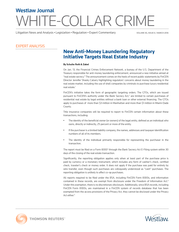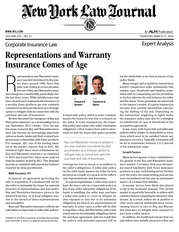Writing the Activism Playbook - the different criteria for reporting activist shareholdings in the United States and United Kingdom – February 2016
Schulte Roth & Zabel
Description
February 2016
don’t count for HSR purposes. Furthermore,
HSR is a prospective obligation; if a filing
is required, it needs to be made – and the
waiting period must be observed – prior to
making the reportable acquisition.
The general question about whether you’re
passive or active for 13D or 13G filings is very
similar to the determination of whether you’re
eligible for the investment-only exemption
under HSR. But it’s not identical, and that’s a
conversation we have all the time with people
who are evaluating, should I do an HSR filing
or shouldn’t I? It’s very similar but there are
very nuanced differences in terms of what
they’re looking for. The HSR guidance on the
investment-only exemption is very focused
on behaviour that would be inconsistent with
an intent to acquire solely for the purpose
of investment, such as seeking board seats
or proposing actions requiring shareholder
approval.
However, the FTC’s leadership has reiterated
that they intend to view the exemption
narrowly, so the contemplation of such actions
may be enough to make the exemption
unavailable.
As a result of recent actions in this area by the
governmental agencies, there’s been growth
in being more conservative about HSR analysis
than there was before.
The way that HSR is being interpreted is evolving, including some actions where the five-member committee that oversees HSR enforcement at the FTC decided three-to-two to go after people – the two dissenters were very vehement in their disagreement with that – but it shows you how close the call is, even among the governing officials in the FTC and DOJ. At the end of the day, that three-to-two edge makes you more conservative than it was before, because that carries the day, three wins over two. HL: And, does the 5% threshold for 13D filings apply across the whole capital structure? 2 EK: In general, yes, but again there are exceptions to everything. It’s more of a complicated question, but for the most part the assumption is yes, it will flow up to the management level because they’re the ones that are exercising that type of investment and voting discretion. And that’s how it’s tested in our rules, so it will flow up across the whole capital structure, with some exceptions. HL: And, what happens if companies have multiple different share classes? Is the effective threshold then much lower as a percentage of the total issued capital? EK: It depends.
It’s really a factual question of analysing the capital structure itself and how it’s determined. For the most part, a simple example in the United States involves a public company that has a class A and a class B stock. Even if they’re not exchangeable into each other, the starting point is to test it on a classby-class basis, so you have to cross a threshold on either class A or class B. Depending on similarities between the classes that may not be the ultimate outcome. Where it becomes more complex is that frequently the one class, which is usually a super-voting class, will be exchangeable into the other class.
That exchange right gives you exposure to not just the class you hold, but to the class that you can exchange into under the United States rules. So as a result of that you have to analyse both of them and you may be crossing thresholds in one with the other or both at the same time. HL: Are shorts within the same firm nettedoff against longs for filing purposes? EK: No, they’re not netted. US determination for a beneficial ownership is based on your long exposure, not short exposure.
You may have to disclose your short exposure as part of a filing, but it’s not netted, meaning, if you own five, and you’re short one, it’s not netted at four, and therefore you don’t have to report. If you’re long five, you have to report that. HL: And if companies are doing share buybacks, how quickly does the share count get updated? EK: In the United States, the rules are that it has to be updated on a quarterly basis, so if you’re a US reporting company (and not as a foreign private issuer, where reporting is less frequent), you have three quarterly 10-Qs and one annual 10-K as your four quarterly reports, with one of them being an annual report. A company is required to disclose in those reports what their share count is and what buy-backs they have done. Companies may disclose it earlier through various filings, such as 8-Ks in the United States, but they’re not required to. So in terms of absolutely knowing what the share count is at any given time, without asking the company or having the company disclose it in some other manner, the only way you will know is by watching those quarterly or annual reports to see it. HL: And in the United Kingdom? JM: Well, the rules are pretty similar in that respect; companies need to publish data as to the number of their shares in issue and in what class, though here in the UK that needs to happen at the end of each month and not quarterly.
It is from those figures that activists will work out whether they have a reportable position under the Disclosure and Transparency Rules; for regulated firms disclosure would normally start at 5%, as it does in the United States. It’s also worth remembering that where the issuer is subject to a UK takeover offer (or is the offeror of such an offer which includes paper consideration (excepting most kinds of debt securities)), there is a second reporting regime under the UK Takeover Code where the threshold is much lower, at 1%. THFJ .
The way that HSR is being interpreted is evolving, including some actions where the five-member committee that oversees HSR enforcement at the FTC decided three-to-two to go after people – the two dissenters were very vehement in their disagreement with that – but it shows you how close the call is, even among the governing officials in the FTC and DOJ. At the end of the day, that three-to-two edge makes you more conservative than it was before, because that carries the day, three wins over two. HL: And, does the 5% threshold for 13D filings apply across the whole capital structure? 2 EK: In general, yes, but again there are exceptions to everything. It’s more of a complicated question, but for the most part the assumption is yes, it will flow up to the management level because they’re the ones that are exercising that type of investment and voting discretion. And that’s how it’s tested in our rules, so it will flow up across the whole capital structure, with some exceptions. HL: And, what happens if companies have multiple different share classes? Is the effective threshold then much lower as a percentage of the total issued capital? EK: It depends.
It’s really a factual question of analysing the capital structure itself and how it’s determined. For the most part, a simple example in the United States involves a public company that has a class A and a class B stock. Even if they’re not exchangeable into each other, the starting point is to test it on a classby-class basis, so you have to cross a threshold on either class A or class B. Depending on similarities between the classes that may not be the ultimate outcome. Where it becomes more complex is that frequently the one class, which is usually a super-voting class, will be exchangeable into the other class.
That exchange right gives you exposure to not just the class you hold, but to the class that you can exchange into under the United States rules. So as a result of that you have to analyse both of them and you may be crossing thresholds in one with the other or both at the same time. HL: Are shorts within the same firm nettedoff against longs for filing purposes? EK: No, they’re not netted. US determination for a beneficial ownership is based on your long exposure, not short exposure.
You may have to disclose your short exposure as part of a filing, but it’s not netted, meaning, if you own five, and you’re short one, it’s not netted at four, and therefore you don’t have to report. If you’re long five, you have to report that. HL: And if companies are doing share buybacks, how quickly does the share count get updated? EK: In the United States, the rules are that it has to be updated on a quarterly basis, so if you’re a US reporting company (and not as a foreign private issuer, where reporting is less frequent), you have three quarterly 10-Qs and one annual 10-K as your four quarterly reports, with one of them being an annual report. A company is required to disclose in those reports what their share count is and what buy-backs they have done. Companies may disclose it earlier through various filings, such as 8-Ks in the United States, but they’re not required to. So in terms of absolutely knowing what the share count is at any given time, without asking the company or having the company disclose it in some other manner, the only way you will know is by watching those quarterly or annual reports to see it. HL: And in the United Kingdom? JM: Well, the rules are pretty similar in that respect; companies need to publish data as to the number of their shares in issue and in what class, though here in the UK that needs to happen at the end of each month and not quarterly.
It is from those figures that activists will work out whether they have a reportable position under the Disclosure and Transparency Rules; for regulated firms disclosure would normally start at 5%, as it does in the United States. It’s also worth remembering that where the issuer is subject to a UK takeover offer (or is the offeror of such an offer which includes paper consideration (excepting most kinds of debt securities)), there is a second reporting regime under the UK Takeover Code where the threshold is much lower, at 1%. THFJ .
Investor Relations Presentations
+
Investor Relations Sub Categories














